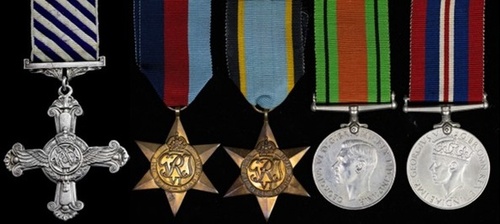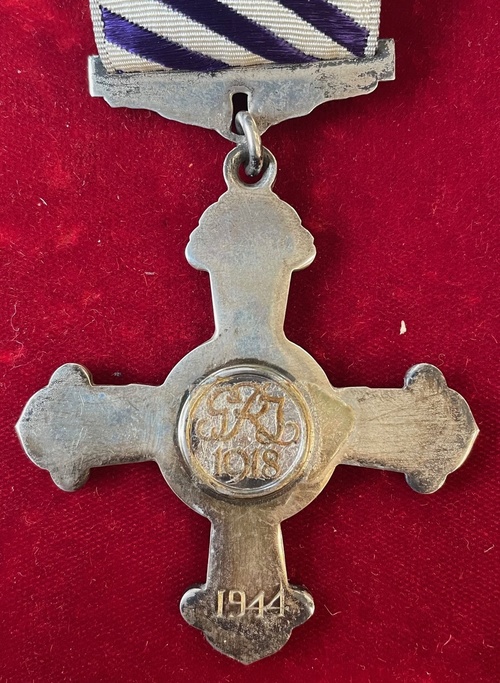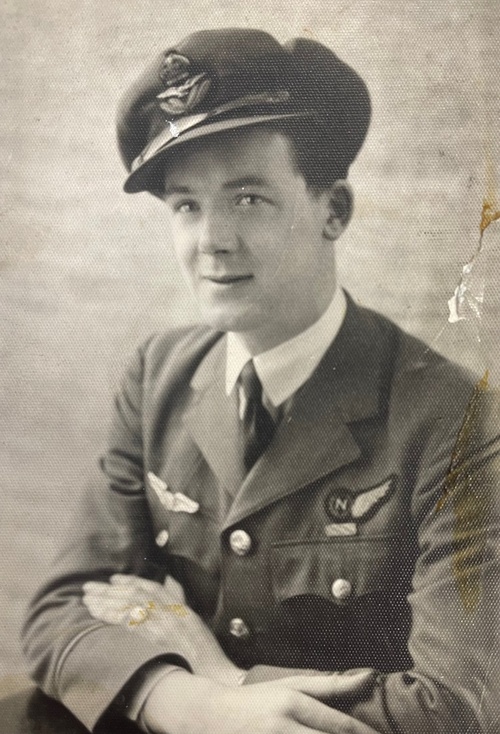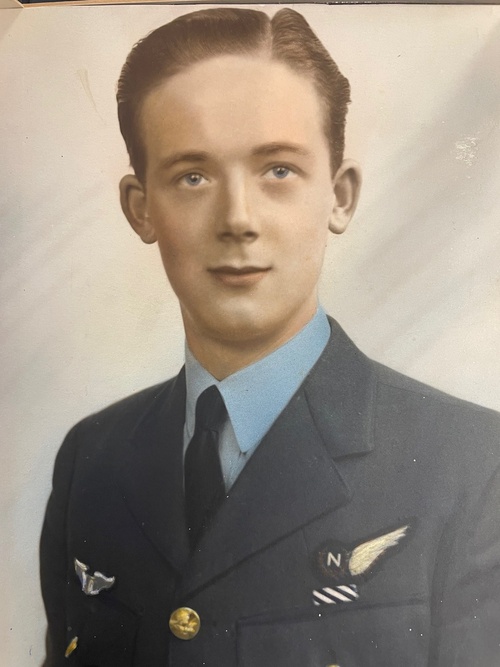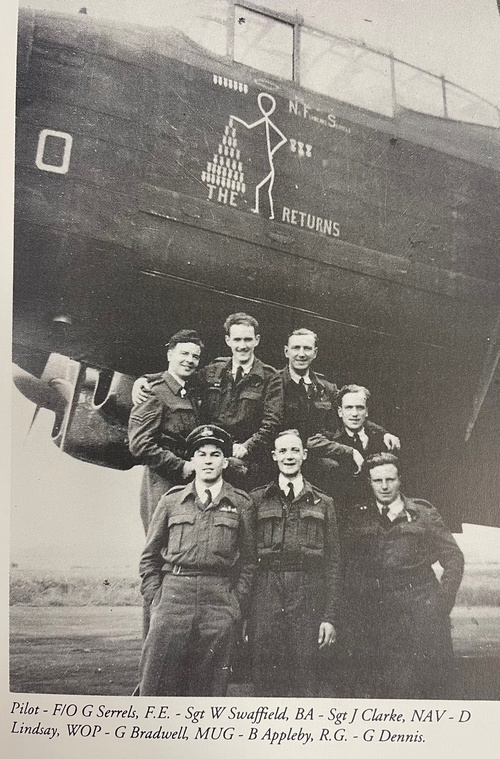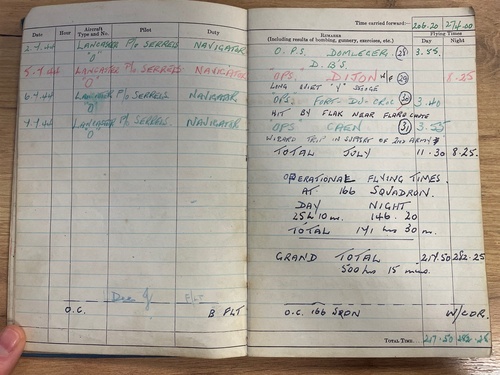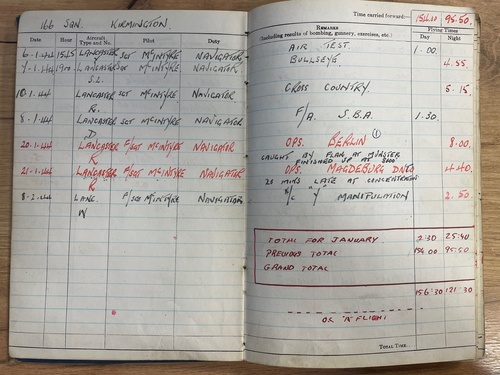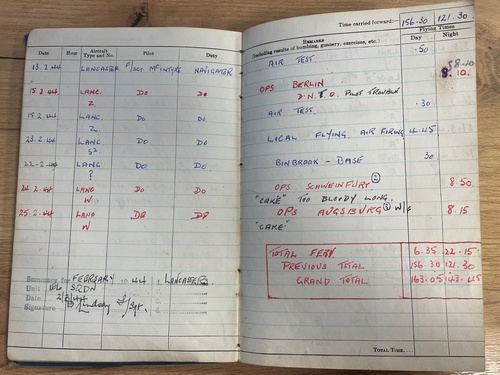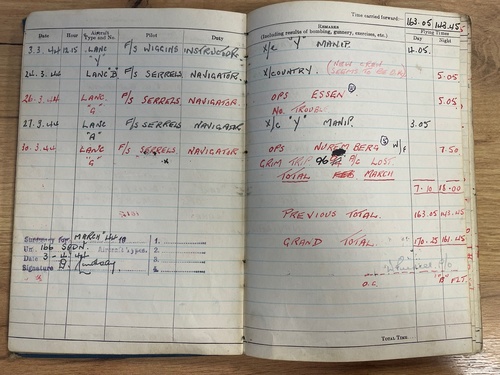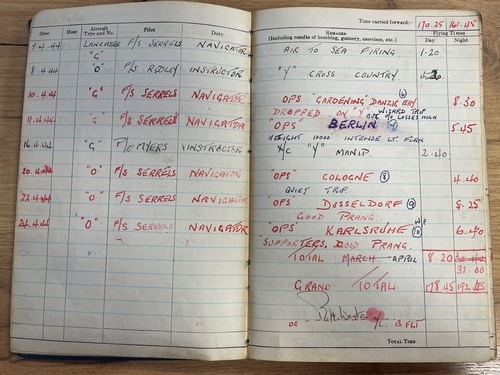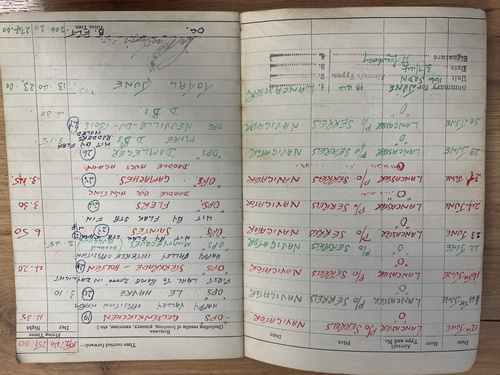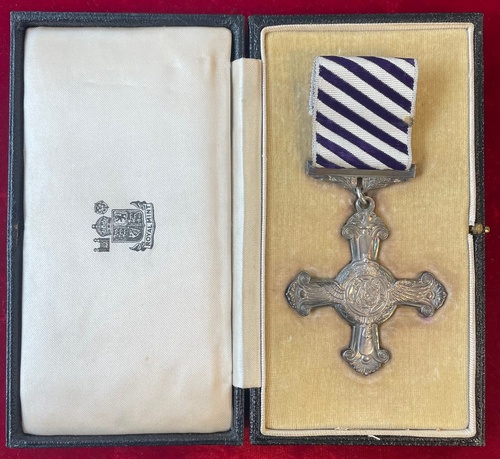Auction: 24113 - Orders, Decorations and Medals - e-Auction
Lot: 678
(x) 'For Pilot Officer Serrels and his crew, it was the final trip of their first tour of operations. Their end of tour celebrations in The Marrowbone and Cleaver (The Chopper) would be tinged with some sadness at the loss of their Flight Commander, Squadron Leader Ralph Weston, but through necessity, their feelings of loss would be brief - not that they did not feel his loss and the loss of so many friends and comrades. But like the rest of the Squadron, they had learned very early on that an outward show of grief was not for them. Too many names had been wiped off the slate already and many more were yet to go out, never to return.'
The show must go on, a sentiment shared by Douglas Lindsay, who flew in Pilot Officer Serrels' crew; On Wings of War - A History of 166 Squadron, by Jim Wright, refers.
A well-documented Second World War D.F.C. group of five awarded to Flight Lieutenant D. D. Lindsay, Royal Air Force Volunteer Reserve, who completed an action-packed tour of 31 sorties as a Navigator in Lancasters of No. 166 Squadron, his aircraft being hit by flak on at least four separate occasions
His introduction to operations commenced with a trip to the 'Big City' on the night of 20 January 1944 - at the height of Bomber Command's Berlin offensive - when his Lancaster was caught by flak and finished up at 8,600 feet, likely after being thrown into a violent corkscrew manoeuvre
Having then somehow survived the disastrous Nuremberg raid on 30 March 1944, he and his crew were diverted to targets of a French nature in the summer, when they flew no less than nine sorties in June alone, four of them of a daylight nature
Distinguished Flying Cross, G.VI.R., the reverse officially dated '1944', with Royal Mint case of issue; 1939-45 Star; Air Crew Europe Star, clasp, France and Germany; Defence and War Medals 1939-45, together with his embroidered Navigator's 'N' Brevet, good very fine (6)
D.F.C. London Gazette 17 November 1944.
Douglas Drummond Lindsay was born on 10 February 1921 and attested for the Royal Air Force as an Aircraftsman 2nd Class in March 1941. Mobilised in February 1942, he was embarked for Canada under the Commonwealth Air Training Scheme, where he attended an Air Navigation School at Port Albert in Ontario. Duly qualified - and having been advanced to Sergeant - he returned to the U.K. in early 1943.
Posted to 12 Operational Training Unit at R.A.F. Finningley in South Yorkshire, where he teamed up with Sergeant McIntyre's crew, Lindsay finally went operational in No. 166 Squadron, a Lancaster unit, at R.A.F. Kirmington in Lincolnshire in January 1944. And, as cited above, his baptism of fire occurred on the night of the 20th, when detailed to attack Berlin - caught by flak, McIntyre had to corkscrew their Lancaster down to 8,600 feet.
Their next sortie - to Madgeburg on the 21st - ended in disappointment on account of their late arrival over the target area, a costly night for Bomber Command with a total loss of 57 aircraft. Then on 15 February, in another strike on Berlin - in fact the largest raid ever mounted against the 'Big City' with 891 participating aircraft - Lindsay noted in his log book 'Pilot trouble'.
Next up was a strike on Schweinfurt on 24 February, part of Operation 'Argument' - or 'Big Week' - in which the R.A.F. and U.S.A.F. mounted a concerted effort to smash enemy factories supporting the Luftwaffe. The attack on the 24th was enacted over two waves, Lindsay noting "Cake" and "Too bloody long" in his log book. Nonetheless, some 60% of the city's industrial sector was destroyed.
Possibly owing to the "pilot trouble" referred to by Lindsay after his trip on Berlin back in mid-February, or else for different reasons, Lindsay ended up joining the crew of new pilot - Flight Sergeant George Serrels - in early March. Now part of 'A' Flight under Squadron Leader Ralph Weston, he flew his first such mission against Essen on the 26th, a 'no trouble' trip with the added benefit that his 'new crew seems to be O.K.'
Events on the night of 30-31 March were of a very different nature, however, namely the disastrous raid on Nuremburg, the costliest sortie ever mounted by Bomber Command with 82 bombers being downed before they even reached the target. Small wonder Lindsay noted in his log book: 'Grim trip'. And he added by way of reason '94 (crossed out and corrected to) 96 a/c lost'. The round trip - in which he surely witnessed not a few of our aircraft plummeting earthwards - had taken seven hours and 50 minutes; Flying Officer Cyril Barton, a Halifax pilot of 578 Squadron, was awarded a posthumous Victoria Cross.
In April, he flew on a 'gardening' trip to Danzig Bay on the 10th, a 'wizard trip' according to his log book, followed by a strike on Aachen on the 11th, where he noted intense light flak at 10,000 feet. Then, in quick succession, he was assigned to raids on Cologne on the 20th, Dusseldorf on the 22nd and Karlsruhe on the 24th, all being assessed as 'good prangs'.
With the advent of May, No. 166 Squadron was assigned to a flurry of French targets, in readiness for the Normandy landings, Lindsay and his crew being assigned to attack the ammunition dumps at Aubigne on the 6th, the fort at Dieppe on the 10th and Orleans on the 19th. He also undertook a brace of 'gardening' trips to Heligoland Bight and Kiel Bay.
The remainder of the month saw him assigned to Duisburg on the 21st - a 'shambles' owing to the cloud cover - and to Dortmund on the 22nd, where the target was clear with numerous searchlights probing the night sky: his Lancaster was hit by flak and its 'cupola destroyed.' It was on this date that he was commissioned as a Pilot Officer in the R.A.F.V.R. (London Gazette 8 August 1944, refers). Finally, on the 24th, he and his crew rounded off one of their busiest operational months with a strike on Aachen, an 'excellent trip'.
The opening weeks of June proved quieter, with a solitary trip to Gelsenkirchen in the Ruhr on the 12th, when Lindsay noted 'Happy Valley, opposition warm', but matters quickly hotted-up. In fact, by the month's end, Lindsay and his crew had flown nine sorties, four of them in daylight. On the 14th it was back to France with a major strike on the E-boat pens at Le Havre, a strike pre-empted by 617 Squadron dropping 12,000 lb. 'Tallboy' bombs, at least one of which penetrated their concrete lair. For his own part, Lindasy proudly noted, 'First Lanc. To bomb 20,000 in daylight.'
Having then returned to 'Happy Valley' with an attack on the synthetic oil plant at Sterkrade on the 16th - 'intense opposition' - he and his crew were assigned to the V. 1 rocket site at Mimoyecques on the 22nd, when their Lancaster was again hit by flak, on this occasion in the starboard tank. And likewise on their next sortie - to Saintes on the 23rd - when hit in the starboard fin. The remainder of the month witnessed further 'doodle bug' operations, with attacks on sites at Flers on the 24th, Gamaches on the 24th, Domleger on the 29th, and Neuville-du-Bois on the 30th, the outing to Domleger witnessing flak damage to their Lancaster's rudders.
Pilot and crew were now nearing the end of their operational tour, hoping no doubt to avoid further close calls with flak. It was not to be, for having returned to Domleger for another 'doodle bug' operation on the 2nd, and hit a target in Dijon on the 5th, their Lancaster was 'hit by flak near the flare chute' in a daylight sortie against Fort-du-Croc on the 6th. One can only imagine their state of anxiety as they took-off on their final sortie on the 7th, a daylight attack on Caen in support of the 2nd Army. Thankfully, it proved to be a 'wizard trip' but others were less fortunate, 'A' Flight's C.O., Squadron Leader Ralph Weston's aircraft being shot down by flak. The Squadron's efforts were duly recognised by a signal received from Montgomery, in which he stated: 'The heavy bombing attack which has just taken place was a wonderful, impressive show. The 2nd Army in Normandy would like their appreciation and thank passed to all crews.'
Lindsay - in common with his pilot - was awarded the D.F.C. and was rested as an instructor at R.A.F. Lindholme in South Yorkshire, where he was promoted to Flying Officer in November1944 and remained employed until V.E. Day.
Having then joined No. 153 Squadron in June 1945, he flew in a Lancaster on a 'Cook's Tour', taking in Rotterdam, Arnhem, Essen, Cologne, Aachen and Antwerp. His final posting was to No. 12 Squadron, in which he was advanced to Flight Lieutenant in May 1946, shortly before his release from the service. He died in Newcastle in 1984.
Sold with an extensive archive of original documentation and photographs, comprising:
(i)
The recipient's R.C.A.F. Observer's and Air Gunner's Flying Log Book, covering the period August 1942 to January 1946.
(ii)
His R.A.F. Airman's Service and Pay Book, issued in February 1942, together with his R.A.F. Airman's Pay Book, issued in August 1942 and R.A.F. Officer's Service and Release Book, with Clearance Certificate dated 6 July 1946.
(iii)
R.A.F. Active Service edition of the Gospel of St. John, the inside cover inscribed to '104098 F./Sgt. Lindsay, D.' of Sutherland, Co. Durham.
(iv)
R.C.A.F. Sight Log Book, the cover inscribed to '104098 Lindsay, D.' and with entries covering the period October 1942 to September 1943.
(v)
A telegram from the recipient's grandmother, congratulating him on completing his flying training, sent from Sutherland on 22 January 1943 ('Congratulations on your wonderful achievement. Good luck always').
(vi)
Third Reich era postcards depicting landmarks in Berlin (8), some with notations to reverse and presumably as 'liberated' by recipient.
(vii)
An impressive wartime photographic archive, including a coloured image of the recipient in uniform, and related original black and white image, dated 6 April 1945; a fine run of group and crew line-ups, covering training days to his operational flying, several bearing signatures to the reverse and including images from No. 166 Squadron; together with aerial photographs taken on a 'Cook's Tour' (8), dated 5 June 1945, as verified in the recipient's Flying Log Book entry of that date, and depicting 'bomber out' locations such as Aachen, Cologne, Essen, Walcheren and Wessel, and a crew line-up taken at R.A.F. Scampton in September 1945, when serving in No. 625 Squadron.
(vii)
A copy of the book On Wings to War - A History of 166 Squadron, by Jim Wright, in which the recipient is mentioned, the inside opening page inscribed by the author, 'With remembrances of Douglas Lindsay, D.F.C.' and signed and dated 'May 2002'; and a copy of the pamphlet A Very Special Lancaster, by F. E. Dymond, being a history of Lancaster Mk. 1 R5868.
Subject to 5% tax on Hammer Price in addition to 20% VAT on Buyer’s Premium.
Sold for
£2,100
Starting price
£1500
Sale 24113 Notices
'Traces of adhesive to reverse of the D.F.C.'

